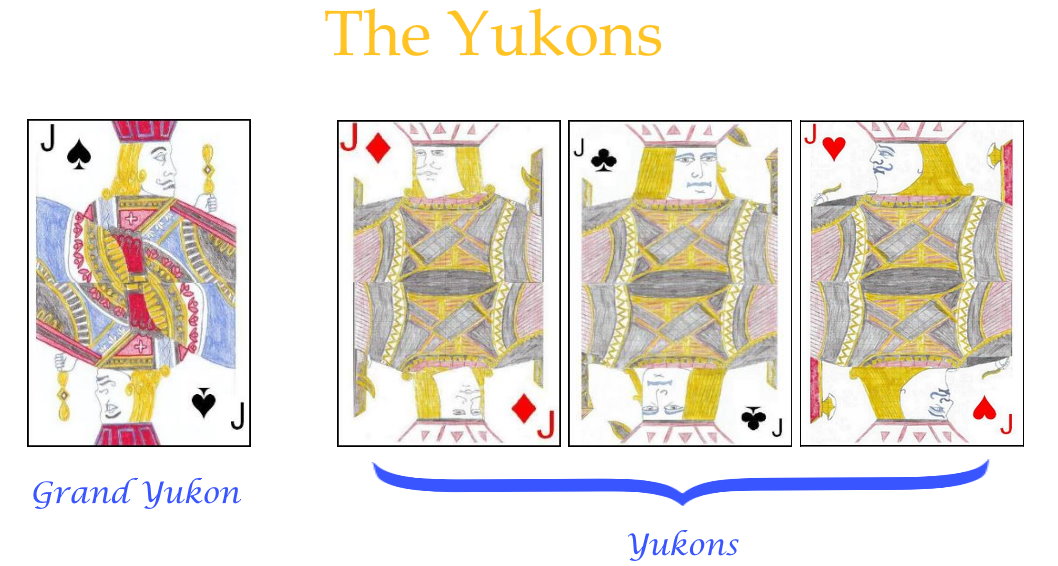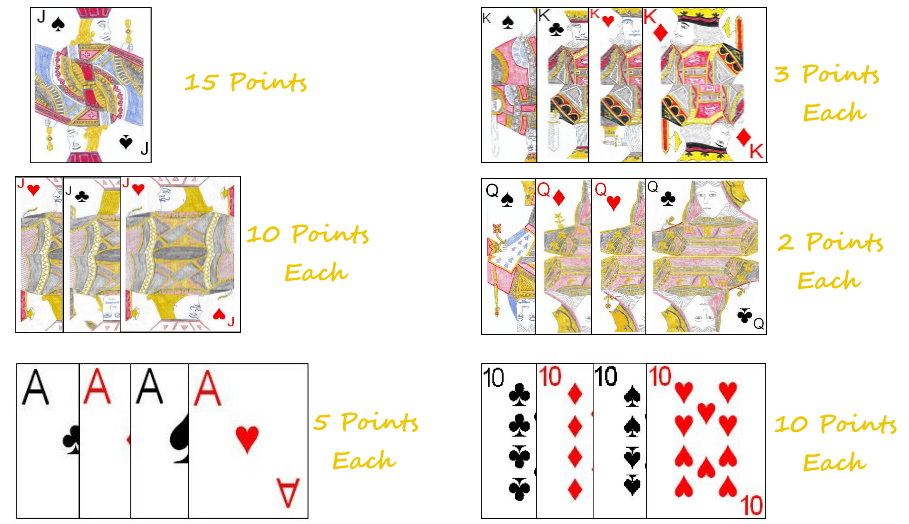Yukon is a little known card game which is played in areas of Canada which are known to have sizable populations of Danish, Swedish or Norwegian individuals. The first known mention of this game in published media is in the card game book "50 Card Games for Children" which was published by Vernon Quinn in 1933. This game, Yukon, has no resemblance to the popular Solitaire game that also goes by the same name. The instructions for that game can be found at this page.
Yukon is designed to be played by four players in two partnerships using one standard 52 card deck. Variants for differing numbers of players are described in variations section, below.
A number of different methods can be used to determine the partnerships for the hand. One common method to do this is to have each player draw one card from the shuffled deck. The players drawing the two highest cards play as partners against the players drawing the two lowest cards. The player who draws the highest card of all is set as the first dealer. Each player should sit directly across the table from his partner.
 To begin the hand the dealer should thoroughly shuffle the deck and pass it to the player at his right to cut. After the cut, the dealer then begins dealing the cards, one-by-one and face down to each player starting with the player at his immediate left and continuing in a clockwise direction from player to player. He continues dealing in this manner until each player has a total of five cards. The dealer then places the remainder of the deck face-down in a pile in the center of the table as the stock pile. The object of the game is for each partnership to win point scoring cards in tricks. To determine the which player will win a trick, each card has a relative ranking. The ranking of the cards in the deck are as follows (from high to low): Ace, King, Queen, 10, 9, 8, 7, 6, 5, 4, 3, 2. The four Jacks are considered the permanent trump suit in this game and are considered to be a suit of their own. In other words, the Jacks are not considered to be a member of any other suit, regardless of the suit actually found on the Jack. The Jack of Spades (called the Grand Yukon) is considered the highest ranked card in the game and the other three Jacks (called the Yukons) are equally ranked as the next highest cards in the deck.
To begin the hand the dealer should thoroughly shuffle the deck and pass it to the player at his right to cut. After the cut, the dealer then begins dealing the cards, one-by-one and face down to each player starting with the player at his immediate left and continuing in a clockwise direction from player to player. He continues dealing in this manner until each player has a total of five cards. The dealer then places the remainder of the deck face-down in a pile in the center of the table as the stock pile. The object of the game is for each partnership to win point scoring cards in tricks. To determine the which player will win a trick, each card has a relative ranking. The ranking of the cards in the deck are as follows (from high to low): Ace, King, Queen, 10, 9, 8, 7, 6, 5, 4, 3, 2. The four Jacks are considered the permanent trump suit in this game and are considered to be a suit of their own. In other words, the Jacks are not considered to be a member of any other suit, regardless of the suit actually found on the Jack. The Jack of Spades (called the Grand Yukon) is considered the highest ranked card in the game and the other three Jacks (called the Yukons) are equally ranked as the next highest cards in the deck.
Traditionally, the oldest player at the table would lead the first card to the first trick on the first hand of every game. For subsequent hands, the first lead would be made by the player to the immediate left of the current dealer.
The leader to a trick can play any card of choice from his hand to lead the trick. Each other player in a clockwise direction around the table would also play one card to the trick. If a player, on his turn has a card of the same suit as led to the trick he must play it (keeping in mind that the Yukons are not considered to be of any specific suit). If he does not have a card of that suit he must play any of the four Yukons to the trick. If he also has no Yukons, he may play any other card from his hand to the trick. If the trick contains the Grand Yukon, the player of that card wins the trick. If not, the trick is won by the first Yukon which was led to the trick. If no Yukons have been played to the trick, the trick is won by the highest card of the suit originally led to the trick.
If a player leads any Yukon as the first card to a trick, each player must play a card of the same suit as marked on the Yukon. If they do not have a card of that suit they must play another Yukon if they have one. Lacking a Yukon, they may play any other card from the hand. This trick is normally won by the Yukon led to the trick, unless a subsequent player led the Grand Yukon to the trick, which will win the trick.
The winner of each trick places the cards won in the trick aside for later scoring. That player then draws one card from the stock, and each player in a clockwise direction then draws a card from the stock to replenish the hand to five total cards. Once all cards from the stock have been exhausted, the players continue playing using the cards remaining in the hand. The winner of each trick leads the first card to the next trick.
After all tricks have been played and won, the hand is scored. Both partnerships combine all the cards won in tricks and determine the number of points earned during the hand. Certain cards in the deck earn the capturing team a number of points. The following chart shows the value of each card as found in the deck:
|
 |
The points earned by each partnership for the hand are then added to that teams collective score for the game. The first team to earn 250 points upon conclusion of a hand is declared the winning team. If both teams have reached or exceeded 250 points, the team with the higher score is declared the winner. If both scores are tied, additional hands must be played until one team ends the hand with a higher score.
 This game is played identically to Yukon with just a few differences in the
standard rules of play:
This game is played identically to Yukon with just a few differences in the
standard rules of play: